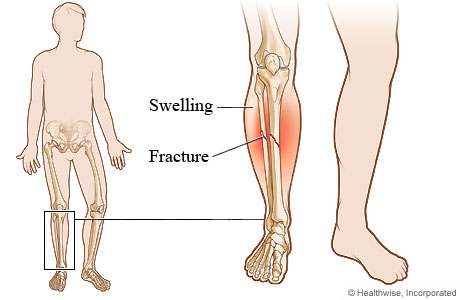Jump to
Lower Leg Fracture

What first aid steps should you take if you suspect a broken leg?
Most minor leg injuries will heal on their own, and home treatment is usually all that's needed. But if you think that you might have a more severe injury, use first aid until you can be seen by a doctor.
- Control bleeding with direct pressure to the wound.
- Remove all anklets or rings right away. It may be hard to remove the jewelry after swelling starts. This can then cause other serious problems, such as a compressed nerve or restricted blood flow.
- Don't try to straighten an injured leg.
- Splint the injured leg to protect it from further injury. Loosen the wrap around the splint if there are signs that the wrap is too tight. Signs include numbness, tingling, increased pain, swelling, and cool skin below the wrap.
- If a bone is sticking out of the skin, don't try to push it back into your skin. It's better to leave the bone alone. Cover the area with a clean bandage.
Lower leg stress fracture: When to call
Call 911 anytime you think you may need emergency care. For example, call if:
- You have severe pain.
Call your doctor now or seek immediate medical care if:
- You have new weakness in your leg.
- You fall on or hurt the injured leg.
- Your pain gets much worse.
- Your leg or foot is cold or pale or changes color.
Watch closely for changes in your health, and be sure to contact your doctor if:
- You do not get better as expected.
©2011-2025 Healthwise, Incorporated
The content above contains general health information provided by Healthwise, Incorporated, and reviewed by its medical experts. This content should not replace the advice of your healthcare provider. Not all treatments or services described are offered as services by us. For recommended treatments, please consult your healthcare provider.
